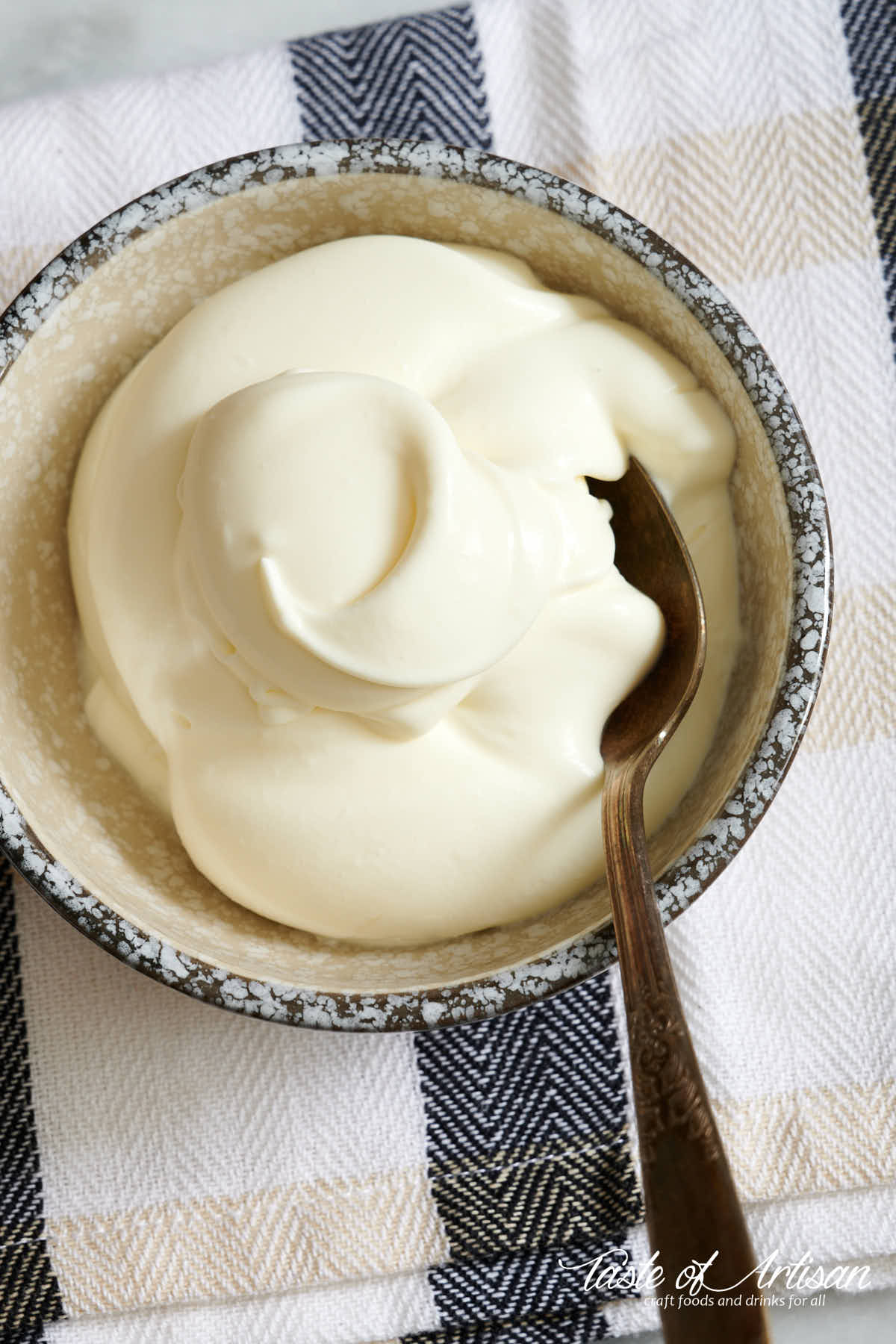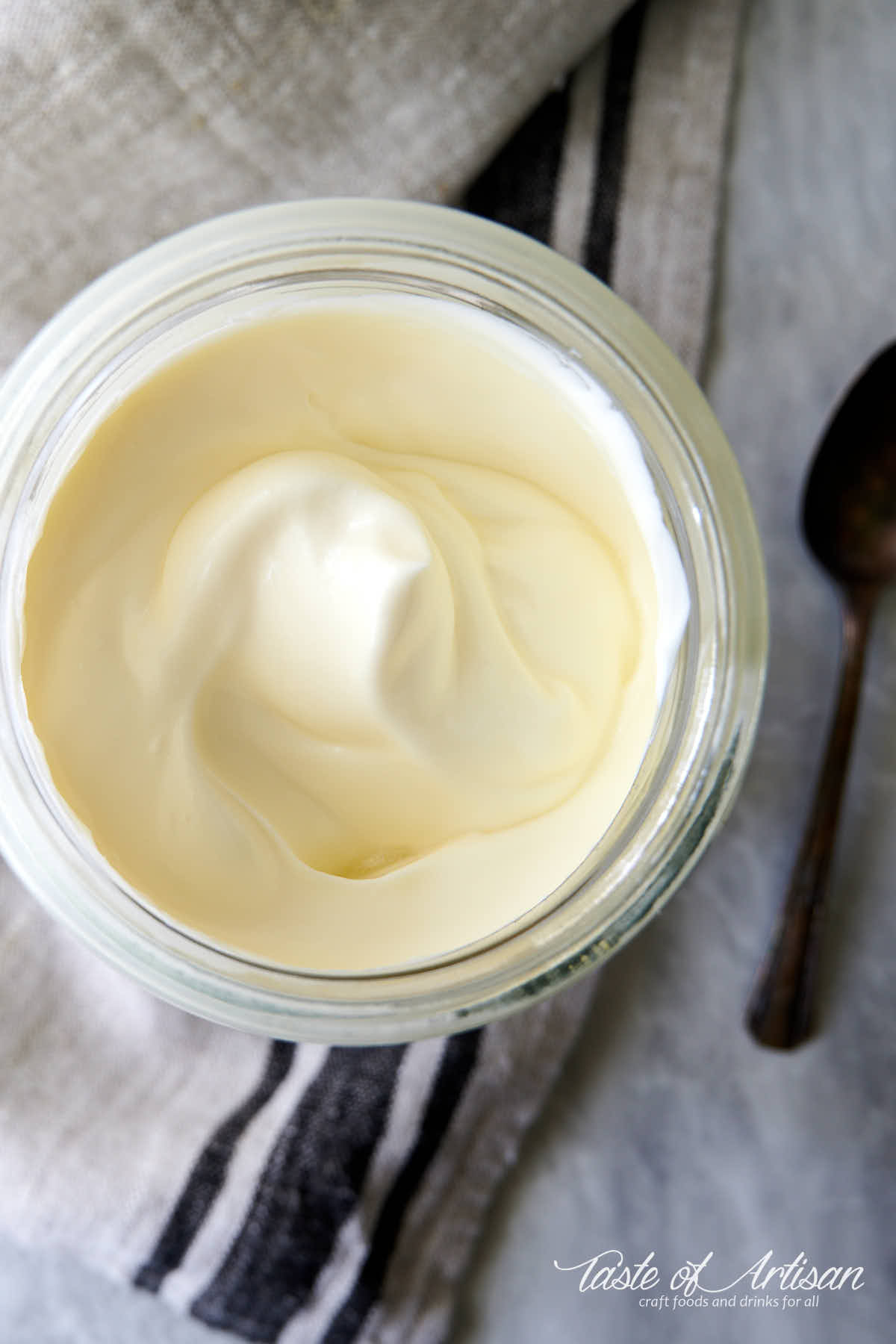Two methods to make consistent and tasty creme fraiche at home.

To date, creme fraiche is the easiest cheese / fermented dairy product that I have made. This is a really good news as we all know how expensive this French 'delicacy' is. Besides, fresh creme fraiche, made without any additives is much tastier. Given this, I hardly ever buy it or use creme fraiche substitutes anymore.
Creme fraiche is made by heating non-ultra pasteurized heavy cream to the optimal temperature of 86F, adding a starter culture to it and letting it ripen at room temperature for about 12-24 hours or even longer. It's that simple.
The most critical part of creme fraiche making process is ensuring that you use a strong, viable starter culture. If the starter culture is weak, you will get a poorly set, runny product. You may not even notice any changes to the cream at all.
There are two ways to get a strong starter culture. One is to use cultured buttermilk. The other one is to use a commercially produced mesophilic starter culture.
Method 1 - using buttermilk as a starter culture
Many new and experienced home cheesemakers initially use store-bought cultured buttermilk until they progress to commercial cultures. Some choose to stick with it as they believe the often wider range of micro-organisms in cultured buttermilk gives them better taste and flavor.
To use this method you must start with cultured buttermilk, which contains live cultures necessary for fermentation. The common challenge with using buttermilk as a starter culture is that it's often not strong enough to be used as a culture. This leads to poor results and a lot of frustration. To overcome this challenge cultured buttermilk needs to be concentrated. I experienced this problem myself and it took me a while to figure out the source of the problem. When using concentrated cultured buttermilk heating cream is not necessary.
Instructions
- Set a 1/4 cup of cultured buttermilk in a 1-quart glass jar on the kitchen counter with the lid cracked open at 70F (21C) room temperature to ripen and increase the bacteria population density. After 6-8 hours the buttermilk will get much thicker, like fresh yogurt, and sourer. This process will take fewer hours if the ambient temperature is above 70F and longer at colder temperatures.
- Add 2 cups of non-ultra pasteurized cream to the jar and stir well. Cover tightly with a piece of cheesecloth and let sit at room temperature 70F (21C) for 24 hours. Stir, put the lid on and refrigerate for 24 hours before using.
Method 2 - using a commercial mesophilic starter culture
This is my preferred method for making creme fraiche as it's very straightforward, provides rich flavor, and does not require building a mother culture aka concentrated cultured buttermilk. Using a properly stored starter culture also ensures very consistent results. My favorite starter culture is Biena Mesophilic Aroma Type B. I use it for making creme cheese, sour cream, goat cheese, buttermilk, and cottage cheese as well. The most economical places to get it from are the cheesemaking.com and glengarrycheesemaking.on.ca.
Traditionally, rennet is not added when making creme fraiche but if you like it a bit firmer, add 1-2 drops of single strength rennet per quart of cream diluted in 1 Tbsp of non-chlorinated water. This is important when using Aroma B or Flora Danica cultures as they produce creme fraiche that's not very firm.
You can also use C33 Creme Fraiche culture or the C20G Chevre culture both of which contain a small amount of rennet.
Instructions
- Pour 2 cups of non-ultra pasteurized heavy cream into a clean glass jar. Place the jar in a pot and fill it with water up to the top level of the cream. Slowly heat the water in the pot to 86F stirring every few minutes. If you have a sous vide immersion circulator use it to heat and ripen the cream. I like the precision of the temperature control it provides.

- Sprinkle 1/4 tsp Aroma B starter culture over the cream and let hydrate for 5 minutes.
- Add the 1-2 drops of single strength rennet per quart of cream diluted in 1 Tbsp of non-chlorinated water if looking for a firmer texture and mix well.
- Cover with a piece of cheesecloth and let ripen for 12 hours in the water bath at 70F-72F ambient temperature. You can also place the pot with the jar inside a large cooler box to keep the water warm. If using a sous vide circulator, set the temperature to 72F.
- Remove from the water bath, stir, cover with a lid and let sit at room temperature for another 6-8 hours for a tangier taste.
- Transfer to the refrigerator and store for up to 2 weeks. Stir before serving.



Robyn says
Once you make creme fraiche with buttermilk can you use the creme fraiche to start another batch?
Victor @ Taste of Artisan says
Yes, if it was made with cultured buttermilk - live buttermilk culture, and you can keep making it indefinitely. If you have access to kefir made from kefir grains (live kefir culture), it's even better as kefir has many live micro-organisms in it, up to 17 vs 1-3. It's thicker and has a lot more flavor. I make my own kefir with kefir grains. It's delicous. Highly recommend it. Good luck!
Angela says
I have been making sourdough bread and yogurt for many years. For both of those, I reserve some of the fed starter to use to start the next batch. In this way, starter cultures last almost indefinitely, baring any contamination. Will this process not work for creme fraiche, as well?
Victor @ Taste of Artisan says
Technically, it should if you start with a good starter culture. I also have a sourdough starter that is many years old, and I make kefir with kefir grains. The only significant challenge I have is maintaining them. It's not easy. Sourdough starter is fine, we bake often. Kefir - I am the only one who drinks it for the most part, so we take breaks by refrigerating the grains for a week-two every so often. We don't use creme fraiche that often, so it would be a challenge... so starting from a dry culture only as needed is a perfect and very convenient solution for me.
Silvana says
Made this recipe last week and didn let it ripen too longer as I was looking for sweeter flavours. As a former professional chef, and someone born in Italy one of my favorite things is mascarpone and I was trying to get that flavour without starting with light cream, then doing curds and drainage and emulsifying again.
Had a friend over for dinner and served this to her atop fresh pan toasted homemade sourdough with amarena cherries and syrup. Her comment was "this is the freshest mascarpone I've ever had! Can you please replicate this?"
I have to agree with her, it's the best of mascarpone, Devon and creme fraiche all rolled into one. Thanks for the awesome recipe, I can tweak it to lean in whatever direction I need. Brilliant!
Victor @ Taste of Artisan says
Silvana, thank you for the interesting and insightful comment. I've actually been making mascarpone with a 50/50 mix of heavy cream and whole milk and use tartaric acid to curdle the dairy mixture. Got so used to that method that I've never thought about using Aroma B starter culture for this cheese but I see how it will improve the flavor and quality of the cheese. Higher fat is always tastier but those calories...;) I made a batch of German-style quark cheese using Aroma B culture, it's turned out very nice too, it's great for making German-style cheese-filled desserts.
Silvana says
I just read your response Victor and chuckled.... By the time you curdle your lower fat cream mix and drain it you have a butterfat content of 44% approx. My full fat cream at 33% doesn't drain and remains 33%. I think if you're worried about fat content or calories the cultured mascarpone wins hands down! 😉
Victor @ Taste of Artisan says
Interesting observation, never thought of it this way... but would like to do a scientific test.
Abino says
Sounds easy but price wise this will cost me twice what store bought creme fresh would cost.
Quart of buttermilk. $4
2 cips 35% cream $5
Victor @ Taste of Artisan says
I use a starter culture, only a small amount is needed and a little bottle of it will go a long way, making the cost of starter culture per batch almost negligible. Heavy cream at Costco is about $5 per quart/liter so 2 cups are about $2.50. An 8-oz jar of good creme fraiche is usually about $6-7. So, it actually makes a perfect financial sense to make creme fraiche at home in this scenario.
Something else to consider - a lot of food hobbyists start because they want to save money. I did. Eventually, they stop caring about the money and care more about the quality of the food and the taste. I make a lot of things at home. Just made a new batch of hard apple cider for example. It's fantastic though I used regular apple juice to make it, nothing fancy. The key is freshness and no added chemicals. Commercial ciders often taste bad/off because of improper storage, exposure to light, oxidation, and use of preservatives like sulfites, potassium sorbate, etc, as those impact the taste.
Harold says
Thankyou,cost of material usually is a choice,that aside I do want to thankyou for your response, and appreciate you kindness in wanting to share a good thing.
Harold
Victor @ Taste of Artisan says
You are very welcome.
Nikole says
Yet another post I'm going share with my buddies on Facebook. Thanks!